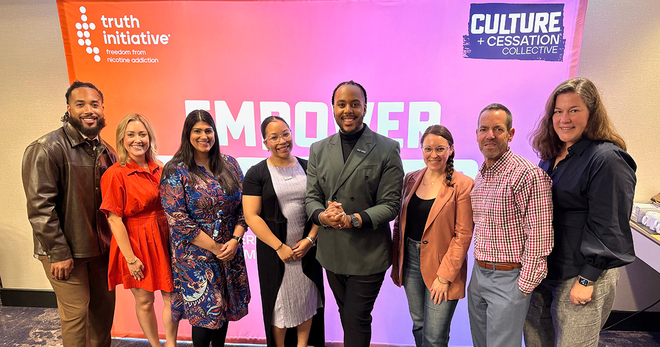3 elements of successful youth advocacy work
Developing young leaders is a critical part of sustainable social change. The truth® Ambassadors program, which is accepting applications for a year-long leadership program for passionate tobacco control advocates to amplify their work, highlights three main objectives to follow for successful youth advocacy.
Ambassadors must create a project that educates people about the harmful impacts of tobacco, engage youth and young adults in their communities and mobilize peers for the truth National Day of Action. Here’s a breakdown of these three key objectives — create, engage and mobilize — with examples.
1. Create a project.
The first step is developing a project or campaign that focuses on effectively educating peers. The project or campaign can align with a common issue or a priority issue that the local community needs to address the most, such as tobacco industry marketing or smoke-free policies, for tobacco control advocacy.
For example, former Truth Initiative® youth activism fellow Lincoln Mondy created the documentary “Black Lives / Black Lungs” to educate his peers about the history, marketing tactics and impact of the tobacco industry targeting African-Americans with menthol tobacco products. For additional support, leaders can reach out to potential partners and organizations who also advocate for the cause to collaborate with them and develop relationships.
2. Engage the community.
Engaging the community with the project or campaign can include planning events and activities to raise awareness of the cause or leading trainings that prepare peers to be advocates. Leaders can use these engagements to connect peers to the issue and showcase what being part of the cause looks like.
Engaging people in the community can be an opportunity for them to get information in ways that they don’t traditionally receive it and see that making change can be fun and engaging. Former Truth Initiative fellow Logan Brown worked with a classroom of American Indian elementary school students to illustrate the pictures for “Denali Dreams,” a children’s book Brown wrote that encourages Native American youth to reject tobacco.
3. Mobilize an action.
After educating peers and showing them that they can be effective activists, it’s important to give them the opportunity to get involved by recruiting and mobilizing them for advocacy actions that support the project or campaign. Leaders can also encourage peers to implement their own projects that address the needs of their specific communities.
Advocacy actions can range from things like collecting petition signatures or letters of support, conducting a survey or even organizing a protest. For example, truth mobilized young people for a zombie-themed demonstration outside a Walgreens in downtown Washington, D.C., to call for the company to protect its customers and stop selling tobacco.
For more information on truth programs for youth leadership in tobacco control and prevention, visit https://truthinitiative.org/youth-leadership.
More in tobacco prevention efforts
Want support quitting? Join EX Program
By clicking JOIN, you agree to the Terms, Text Message Terms and Privacy Policy.
Msg&Data rates may apply; msgs are automated.


